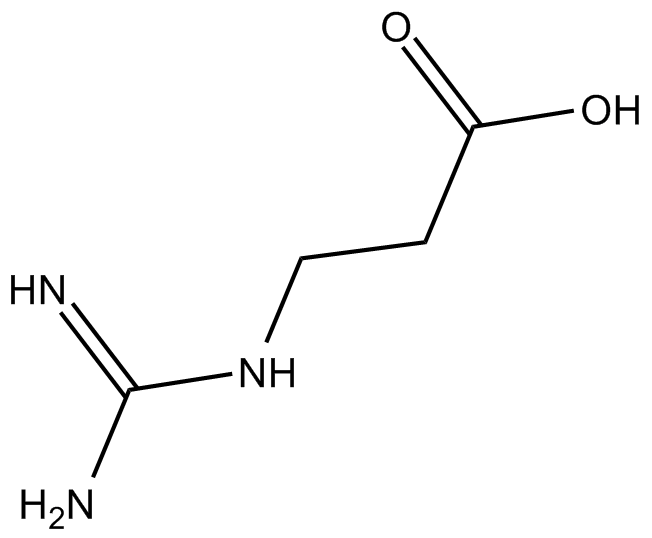3-Guanidinopropionic Acid (Synonyms: β-GPA,PNU 10483) |
| Catalog No.GC13992 |
RGX-202 (3-Guanidinopropionic acid) is an oral small-molecule SLC6A8 transporter inhibitor. RGX-202 robustly inhibits creatine import in vitro and in vivo, reduces intracellular phosphocreatine and ATP levels, and induces tumor apoptosis. RGX-202 can be used for the research of cancer and duchenne muscular dystrophy.
Products are for research use only. Not for human use. We do not sell to patients.

Cas No.: 353-09-3
Sample solution is provided at 25 µL, 10mM.
3-Guanidinopropionic Acid is an AMP-activated protein kinase (AMPK) stimulator and PPARγ coactivator 1α (PGC-1α) activator.
AMP-activated protein kinase is an enzyme involved in cellular energy homeostasis. AMPK activation has been involved in stimulation of hepatic fatty acid oxidation, ketogenesis, skeletal muscle fatty acid oxidation and glucose uptake, inhibition of cholesterol synthesis, lipogenesis, and triglyceride synthesis, inhibition of adipocyte lipolysis and lipogenesis, and modulation of insulin secretion by pancreatic beta-cells [1]. PGC-1α is a transcriptional coactivator involved in regulating the genes implicated in energy metabolism and mitochondrial biogenesis, such as the the expression of AMPK, genes for oxidative phosphorylation, electron transport chain, and mitochondrial biogenesis, increasing oxidative muscle fibers, numbers of mitochondria, and motor performance [2].
3-Guanidinopropionic acid improved insulin sensitivity and promoted weight loss selectively from adipose tissue in animal models of non-insulin-dependent diabetes mellitus (NIDDM). 3-Guanidinopropionic acid was a substrate for both the creatine transporter and creatine kinase [3]. In KKAy mice with noninsulin-dependent diabetes, 3-guanidinopropionic acid decreased the plasma glucose level. In insulin-resistant rhesus monkeys, 3-guanidinopropionic acid increased the disappearance of i.v. glucose [4].
References:
[1] Winder W W, Hardie D G. AMP-activated protein kinase, a metabolic master switch: possible roles in type 2 diabetes[J]. American Journal of Physiology-Endocrinology And Metabolism, 1999, 277(1): E1-E10.
[2] Chaturvedi, R. K.,Adhihetty, P.,Shukla, S., et al. Impaired PGC-1α function in muscle in Huntington’s disease. Human Molecular Genetics 18(16), 3048-3065 (2009).
[3] Larsen S D, Connell M A, Cudahy M M, et al. Synthesis and biological activity of analogues of the antidiabetic/antiobesity agent 3-guanidinopropionic acid: discovery of a novel aminoguanidinoacetic acid antidiabetic agent[J]. Journal of medicinal chemistry, 2001, 44(8): 1217-1230.
[4] Meglasson M D, Wilson J M, Yu J H, et al. Antihyperglycemic action of guanidinoalkanoic acids: 3-guanidinopropionic acid ameliorates hyperglycemia in diabetic KKAy and C57BL6Job/ob mice and increases glucose disappearance in rhesus monkeys[J]. Journal of Pharmacology and Experimental Therapeutics, 1993, 266(3): 1454-1462.
Average Rating: 5 (Based on Reviews and 6 reference(s) in Google Scholar.)
GLPBIO products are for RESEARCH USE ONLY. Please make sure your review or question is research based.
Required fields are marked with *




















